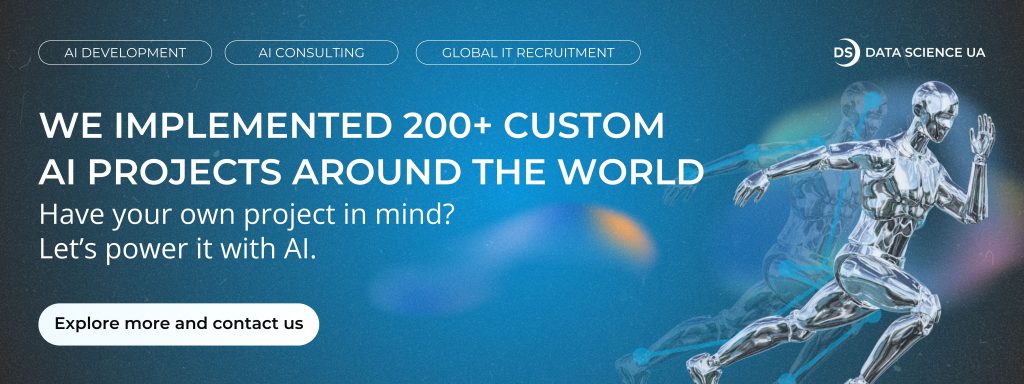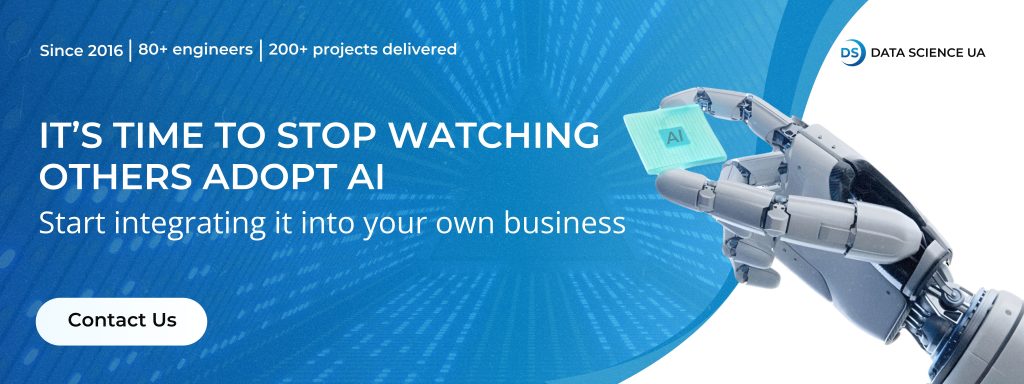AI recommendation system explained: Types, algorithms, and cases
Recommender systems have grown into an indispensable part of doing business in today’s digital world: improving user experience, driving sales, and nurturing customer loyalty. Such intelligent systems analyze vast amounts of data to provide personalized recommendations that profoundly influence consumer behavior. In this article, the AI recommendation system types, functionalities, and real-world applications will be discussed, and readers will see how organizations can leverage them for maximum impact. Refer to AI agent development services for more.
Understanding recommendation engines and their importance
Recommendation systems AI are algorithms designed to propose items relevant to users in line with their preferences, behaviors, and interactions. They form the backbone of various industries, from e-commerce and travel to entertainment, as they enable the business to offer personalized content to users.
Role in improving customer experience
The key objective of an AI-based recommendation system is to improve customer experiences through personalized suggestions. These systems analyze user behaviors and preferences to offer them relevant products, services, or content that best match their interests. Such personalization enhances customer satisfaction and makes them come back for more, thus creating loyalty and long-term engagement.
For example, Amazon is an e-commerce platform that uses an AI-powered recommendation algorithm that looks and observes users’ history of browsing, their previously made purchases, and even products that are often purchased together. By giving consumers personal product recommendations both on their homepage and through the checkout process, Amazon boosts its chances of adding on to each sale quite radically. An estimated 35% of Amazon’s revenue comes from its artificial intelligence recommendation engine. Check out optical character recognition services for more!
Check out our AI chatbot development company
Key types of recommendation systems
There are several types of recommendation system AI, each with distinct methodologies for generating suggestions. Understanding artificial intelligence recommendation engine is essential for businesses looking to implement effective recommendation systems.
Collaborative filtering methods
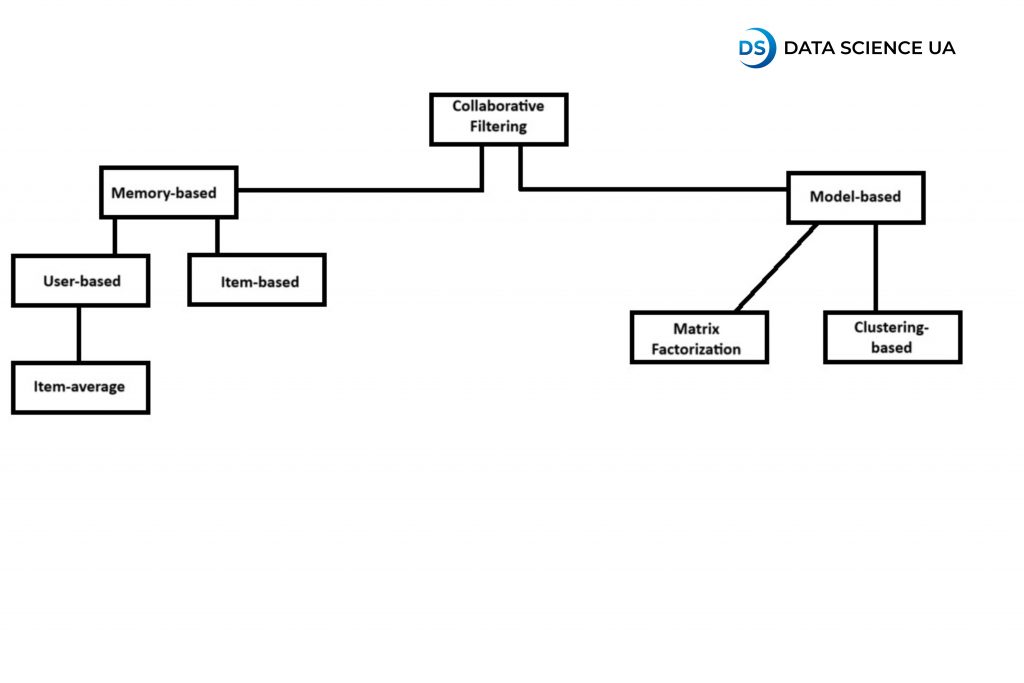
Collaborative filtering is one of the most popular approaches in recommendation systems. It’s used to personalize the digital experience, from movies on Netflix to merchandise in e-commerce. The main idea is to identify similarities between users or objects based on historical interaction data. CF does not require information about the products themselves – it focuses solely on behavior.
Several collaborative filtering methods are used in the industry. They are conditionally divided into two large groups:
Memory-based
These methods use the entire user interaction matrix without model training. They work well on small to moderately large datasets and are easy to interpret. They are divided into two subtypes:
User-based collaborative filtering
The system finds users with similar tastes and generates recommendations based on their preferences. If you and another user rated several films the same, and he rated another film highly, it will probably suit you too.
Examples:
- Item-average: the easiest option when a user is offered an object if it is popular with similar users.
- K-Nearest Neighbors (kNN): Searches for the nearest N users with similar ratings.
- Cosine similarity/Pearson correlation: used to measure similarity between users.
Item-based collaborative filtering
Here everything is built around objects. The algorithm looks for products that are often selected together or receive similar ratings. Recommendations are formed based on what you have already watched or bought.
Examples:
Item-to-item kNN: Amazon is actively pursuing this method.
Adjusted cosine similarity: evaluates the similarity of two objects, adjusting the personal characteristics of users.
Model-based
When the amount of data grows, memory-based approaches start to work slowly or become inaccurate. Model-based methods offer scalable solutions. They build models by learning from historical data and can make predictions for new users or products.
Matrix factorization-based
One of the most popular and accurate approaches. It splits the interaction matrix into two smaller ones: the user matrix and the object matrix. The idea is to represent users and objects in a common vector space.
Examples:
- Singular Value Decomposition (SVD)
- Non-negative Matrix Factorization (NMF)
- Alternating Least Squares (ALS)
- FunkSVD (without characteristic matrix)
- Application: Widely used on large e-commerce platforms and streaming.
Clustering-based
The method groups users or objects by similar characteristics. For example, users with similar ratings cluster, and new users are offered what is popular in their group.
Examples:
- K-Means Clustering
- Hierarchical Clustering
- Spectral Clustering (for complex graphs)
The approach is convenient for segmenting the customer base and creating personalized recommendations within groups.
Deep learning-based
A modern approach that can take into account not only interactions, but also content, time dependencies, texts, images.
Examples:
- Autoencoders
- Neural Collaborative Filtering (NCF)
- Graph Neural Networks (GNN)
Such models can be trained on multimodal data and be very accurate, but require more computing resources.
Content-based algorithms
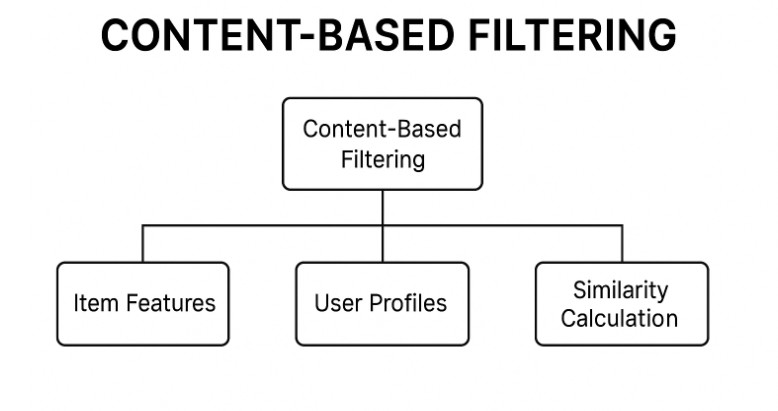
Types of content-based filtering
Content-based filtering bases recommendations on the features of items. It analyzes the characteristics of items a user has liked or interacted with and suggests other items that share similar features. For example, if a user likes action movies, the system will recommend other action films based on genre, cast, or director. Spotify is one great example of a platform that recommends content, analyzing features from songs and artists a user has liked to make a new suggestion that better suits their taste.
Combining techniques in hybrid systems

Hybrid recommendation systems combine collaborative filtering and content-based filtering to leverage the strengths of both methods. Integration of multiple approaches could provide more accurate and diverse recommendations. A classic example is YouTube, which applies a hybrid model in recommending videos based on a user’s viewing history and metadata of the videos. This combination ensures that users receive a well-rounded selection of content tailored to their interests.
Leveraging context for better results
Contextual recommendation systems use contextual information such as location, time, or user activity to make more relevant suggestions. For instance, a travel application might recommend activities based on the current location and time of day, making the suggestions even more relevant. Airbnb makes context-aware recommendations by offering accommodation and experiences based on what users have searched for in the past, their current location, and even the season, ensuring that whatever they are shown is timely and relevant.
The role of Machine Learning in recommender systems
Machine learning is very important in the development and optimization of AI Recommender Systems. Using complex algorithms, businesses can improve recommendations with each new user interaction and feedback. Such a recursive learning process helps adapt systems to changes in user preferences and enhances the overall accuracy. For organizations that want to implement advanced machine learning solutions in their ai based recommendation system, go on and check out ml development services.
Top use cases for AI recommendations
Artificial intelligence recommendation engine has been employed for various industries, all reaping the benefits of how the technology can improve user experiences and business performance. And the right AI development company can assist you!
E-commerce: Powering sales with personalization
AI recommendation systems are a key factor in driving sales in e-commerce. By analyzing user behavior and preferences, online retailers will make suggestions to customers that may align with their interests and therefore increase the chances of converting. For example, sites like Amazon and eBay employ an AI recommendation algorithm that makes suggestions for products based on previously purchased items, search terms, and browsing history. This not only enhances customer experience but also increases sales considerably.
Media: Engaging viewers with relevant content
Applications like Netflix and Spotify have recommendation engines that make use of artificial intelligence, whereby viewers and listeners can engage with more personalized content. These analyze the interactions of users and recommend certain shows, movies, or songs that would best fit the taste of the individual user, further enhancing user satisfaction and retention. The point that possibly best portrays the use of personalized recommendations for better user engagement is that, according to Netflix, 80% of the content watched on its platform is driven by its AI recommendation tool.
Finance: smarter banking recommendations
AI in fintech will provide personalized insights into product suggestions based on users’ spending habits and financial goals. Banks can suggest suitable credit cards, investment products, or savings plans for each particular user based on his or her financial situation. Mint is a personal finance application that uses recommendation algorithms to give users budgeting tips and financial product suggestions based on their spending habits and goals, enabling them to manage their finances more effectively.
Logistics: optimizing supply chains
AI in logistics & supply chain works for the optimization of supply chain operations. Analyzing data on inventory levels, customer demand, and supplier performance allows businesses to make informed decisions on restocking and managing their inventory, further enhancing efficiency and reducing costs. Indeed, Walmart deploys advanced recommendation algorithms to predict inventory needs about seasonal trends, sales data, and local tastes to make sure the right products are in stores at just the right time.
Travel and hospitality experiences
Travel and hospitality industries enhance customer experiences through recommendation systems. The platforms analyze user preference and booking history to come up with personalized travel package suggestions, places of residence, and activities. Expedia, for example, advises on hotels and activities for users based on their history of searches and bookings earlier, thus making it much easier for travelers to create plans for their trips.
Healthcare personalization
AI in healthcare can provide personalized treatment plans and health management suggestions based on patient data and medical history. By leveraging AI, healthcare providers can enhance patient outcomes and deliver tailored care. For example, IBM Watson Health uses recommendation algorithms to analyze patient data and suggest personalized treatment options, improving the quality of care provided to patients.
Benefits of recommendation systems for business
Recommendation systems have a lot of advantages in implementation for businesses willing to improve their operations and customer interactions.
Increasing customer loyalty
Personalized recommendations create a more personal relationship between customers and brands. Consistent delivery of relevant content helps businesses build trust and loyalty, thus encouraging customers to come back for more.
Improving cross-channel experiences
Recommendation systems can help provide frictionless cross-channel experiences where suggestions are consistently made across platforms. For instance, a customer viewing a product on a mobile app would receive the same recommendations when browsing the website for continuity in experience. This approach is crucial to keep customers engaged and satisfied.
Enhancing content relevance
AI-powered recommendations can be used to make sure that the content presented to users is relevant and interesting. This relevance not only fuels user satisfaction but also leads to higher conversion rates. An example of recommendation algorithms is in how Facebook curates news feeds for users, showing posts from friends and pages they interact with most, increasing engagement on the site.
Increasing operational efficiency
In many ways, recommendation systems optimize a variety of business operations, from inventory management to advertising strategies. By analyzing trends and making predictions, it helps businesses make informed decisions with much enhanced operational efficiency. For instance, the fashion retailer Zalando uses recommendation systems to better manage inventory through the prediction of products most likely to sell based on the behavior and preference of each customer.
How do recommendation systems work?
Understanding how recommendation systems work is key to implementing the technology efficiently in a business.
Data gathering
The process of building a recommendation system starts with data collection. Data can be collected from a variety of sources, such as user interactions, purchase histories, and demographic information. Collected data forms the foundation on which personalized recommendations are made. In this regard, Netflix collects data on user viewing habits, ratings, and even time spent on each title in making recommendations.
Storing and organizing information
Following the collection of data, the information needs to be stored in an organized and structured way. Most organizations rely on databases or a repository system to store information for access and manipulation; Google utilizes highly developed ways to store user data derived from the usage of its variety of services, then processes the same for desired outputs effectively.
Data processing and analysis
After data has been organized, it undergoes processing and analysis in order to have insights that inform recommendations.
Filtering techniques
It filters lots of data items and, after filtering, gives suggestions based on some items considered relevant. Different filtering approaches are used: collaborative, content-based, or hybrid methods. They can all jointly contribute to enhancing the strength of the recommendation. For example, LinkedIn does that by a combination of collaborative and content-based filtering on job posts or even people recommended to you. It enables easy professional networking.
Machine Learning algorithms
These are at the core of any given analysis of user behaviors and preferences. Using some well-known machine learning algorithms like clustering, classification, and regression, businesses can highlight regularities and trends that drive recommendations. For instance, Spotify uses clustering algorithms to group users with similar listening habits. These enable the platform to then suggest to them songs and playlists that better fit their musical tastes.
Common challenges in AI-powered recommendations
While AI powered recommendation systems offer significant benefits, they also present several challenges that organizations must address.
High costs and technical complexity
However, creating and maintaining sophisticated systems tends to be expensive and requires special technical skills. Companies would need to invest in building and sustaining the infrastructure, the proper tools, and the capabilities involved to implement such systems. Some companies, like Netflix, require a huge investment in infrastructure and data science groups to keep continually updating their recommendation algorithms.
Scalability and speed
With growing user bases, recommendation systems have to be kept fast and scalable. This is where organizations should realize the need for solutions that handle volumes of data and provide recommendations in real-time. For instance, Alibaba has built scalable recommendation systems that support millions of user interactions per second at peak shopping times and ensure a seamless customer experience.
Irrelevant or unhelpful suggestions
The problem usually encountered in recommendation systems is irrelevance and unhelpfulness. The algorithms have to be so well-tuned to user preferences; otherwise, the recommendations will go haywire, frustrating the users. Hence, sites like Amazon continually update their algorithms using feedback and interaction data for better relevance of their suggestions.
Reducing bias in recommendations
Moreover, recommendation systems are highly vulnerable to bias, which can then yield mere limited suggestions that do not represent the actual preferences of the users. Organizations should thus adopt mechanisms for detecting and mitigating bias in algorithms. For example, YouTube tried to eliminate bias in the recommendation systems by diversifying the content recommended to the users to ensure that a wide range of perspectives is presented to them.
Data privacy and compliance issues
With increased stringency in the regulation of data privacy, an organization has to make sure its recommendation system fully adheres to all relevant legislation: it should not collect any data without users’ consent and maintain substantial security for sensitive information. Companies like Facebook and Google have invested a lot in compliance measures so that their recommendation systems will align with privacy regulations such as GDPR.
Building a recommendation system: Key steps
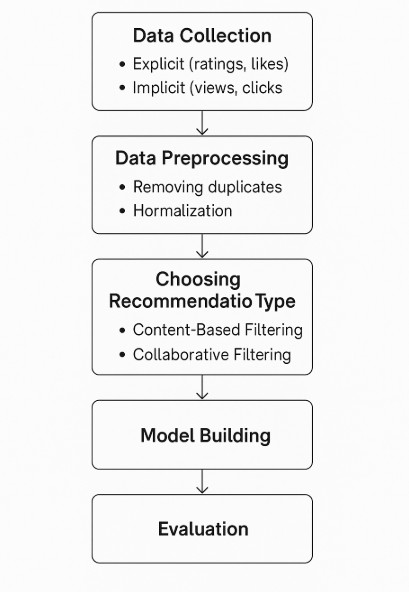
Checklist on how to build a recommendation system
Creating an effective recommendation system involves several key steps, from planning to deployment.
Planning and project scoping
The first step in any recommendation system is to establish the project objectives and the scope. Organizations have to indicate what the system will do, for whom, and which functionalities are needed. A company such as Zalando might set objectives aimed at increasing sales, based on personalized product recommendations by user behavior. Here’s the example:
import pandas as pd
ratings = pd.read_csv(‘ratings.csv’) # userId, movieId, rating
movies = pd.read_csv(‘movies.csv’) # movieId, title
import pandas as pd
This line imports the pandas library, which is widely used for working with table data (tables are similar to Excel tables).
pd is an alias (alias) to shorten further function calls (pd.read_csv instead of pandas.read_csv).
🔹 pd.read_csv(‘ratings.csv’)
This is a function that reads a CSV file (comma-separated values) and returns a DataFrame object – a special data structure in pandas that resembles a table.
‘ratings.csv ‘is a file with estimates, where, for example, each line is:
userId,movieId,rating
1,31,2.5
1,1029,3.0
…
DataFrame ratings stores information:
userId – user ID
movieId – movie ID
rating – rating of the film by this user (for example, from 0.5 to 5.0)
pd.read_csv(‘movies.csv’)
This line reads another CSV file containing movie information.
‘movies.csv ‘- may look like this:
movieId,title
1,Toy Story (1995)
2,Jumanji (1995)
…
DataFrame movies contains:
movieId – identifier (the same as in ratings.csv)
title – the name of the film
Data cleaning and preparation
After data is collected, cleaning and preparation are necessary to ensure the accuracy and reliability of the data. This includes removing duplicate entries, handling missing values, and transforming the data into a proper format for analysis. For instance, Netflix continuously cleans its data on user interactions to ensure it is accurate and current to provide recommendations effectively.
Training and refining models
With prepared data, organizations can then begin to train machine learning models on the clean data. This includes choosing appropriate algorithms, tuning hyperparameters, and iteration to improve model performance. Companies like Spotify continuously fine-tune their algorithms on the ever-changing user feedback and listening patterns to increase the accuracy of recommendations.
Testing and optimization
Once the models are trained, they need to be put through comprehensive testing to assess their efficiency. The organization should check the precision of the recommendations and make further modifications to optimize the performance. For instance, Amazon performs extensive A/B testing on different recommendation strategies to ensure that they achieve maximum user engagement and sales.
Deployment of the recommendation engine
After testing and optimization, the recommendation engine can be deployed within the target application or platform. In this step, the integration of the engine with already existing systems is involved, making sure it works perfectly. On eBay, for example, the recommendation engine is integrated into its mobile app and website to make personalized suggestions to users across all platforms.
Monitoring and maintenance
Post-implementation, it is very important for an organization to monitor the recommendation system continuously. This is essential in terms of regular maintenance that solves issues arising, updates algorithms, and makes sure the system adapts to changes in user preferences. Companies like Netflix practice continuous monitoring of their recommendation systems, using real-time data to make necessary adjustments and improvements.
Choosing the best recommendation engine
For a business that works with a large amount of data and wants to increase user engagement or increase sales, the AI powered recommendation system can be a key tool. However, in practice, the question often arises: how to choose a suitable engine? Where to start if you don’t have a technical team, but the task is to reduce the flow of customers or offer relevant goods? Let’s figure out what you should pay attention to and why there is no universal solution.
Custom-built vs. Ready-made recommendation engines
The first thing any company faces is the choice between a ready-made solution and creating a custom system from scratch.
Ready-Made solutions are tools such as Google Recommendations AI, Amazon Personalize or SaaS services built through the API. They will suit companies that need to quickly run a recommendation system without going into technical details. Most often, they work on the principle: uploaded data – got the result. It’s convenient, but not always flexible.
Pros:
- Quick start
- Support and documentation
- Technical expertise – on the side of the service
Minuses:
- Limited customization options
- Binding to the provider’s ecosystem
- Potential data privacy issues
Custom engines are built for specific purposes: you can take into account unique business logic, the peculiarities of customer behavior, metrics of success that are important to you.
Pros:
- Full control over algorithms
- Flexibility in the selection of architecture (for example, hybrid models, content filtering, reinforcement learning)
- Scales better over long distances
Minuses:
- Requires a team of developers
- More expensive at the start
- Harder to service.
Pricing models affect your budget
Choosing an engine is also a matter of money. Not only the cost of development, but also the cost of ownership.
SaaS models typically offer a monthly payment based on the number of recommendations, users, or data volume. It’s convenient in a short cycle – especially if you want to test a hypothesis. But with rising traffic, the cost can quickly increase. For example, Amazon Personalize charges for model training, data storage and the number of API calls. In the end, the check can exceed the budget for marketing.
Custom solutions require investments at the start: architecture, development, testing. But in the long term, they may be cheaper, especially if the model is trained locally, without transferring data to third parties.
Also worth considering:
- Integration cost: do I need to connect the engine to the site, application, CRM or email services?
- Licensing and security: where are the data stored, who is responsible for protecting them?
- Flexibility of scaling: has the price increased when users grow?
Algorithm for optimal performance
There is no universal algorithm that is “better than all.” The choice depends on your goals, data structure and metrics.
Here are the main options:
- User-based collaborative filtering: finds similar users and recommends what they like. Suitable for media platforms and marketplaces. Easy to implement, but does not work well with a small amount of data (cold start problem).
- Item-based collaborative filtering: Looking for items that are similar to what you have already evaluated. It works more stable and scales better, especially in e-commerce.
- Content-based filtering: analyzes attributes of goods and profiles of users (genres, themes, interests). Useful if you offer rare or niche content.
- Matrix Factorization: advanced technique that helps to reveal hidden laws between users and goods. Used in Netflix, Spotify and other major platforms.
- Hybrid Systems: combine approaches. For example, they use content filtering at the start, and then switch to collaborative. Or combine product recommendations with trends to increase engagement.
Ongoing maintenance and support
The recommendation system is not “once set up and forgotten”. She needs it regularly:
- Retrain on new data
- Track the quality of recommendations (e.g. through NDCG metrics, Precision @ K, A/B tests)
- Update algorithms for changed behavior scenarios
- Monitor logs and performance drops
Ready-made decisions take it upon themselves. But with them, you have less control over exactly how that happens.
Own engines require separate infrastructure, monitoring and a team that will maintain the entire pipeline: from downloading data to the interface for analysts.
Don’t forget about the legal side: especially if you are processing personal data of users. Not all SaaS platforms comply with the requirements of the GDPR or local regulators. If you have European clients, this factor is critical.
Data Science UA’s capabilities in recommendation systems
At Data Science UA, we specialize in developing advanced AI recommendation system tailored to meet the unique needs of our clients. Our capabilities include:
Delivering product recommendations
We develop intelligent product AI powered recommendation system that analyze user behavior and preferences, offering personalized suggestions to drive conversions and improve customer satisfaction. For instance, it could analyze past purchases and browsing history to suggest relevant products to the consumer’s interests.
Collaborative filtering implementation
Our team is highly skilled at the implementation of collaborative filtering techniques in finding similarities among users and suggesting items based on the preferences of similar-minded users. This way, a business can tap into the wisdom of the community and, therefore, provide much more accurate recommendations.
Developing hybrid recommender systems
We apply hybrid approaches, which join collaborative filtering with content-based filtering to make diverse and accurate recommendations and provide a rich user experience. This approach enables us to represent user preferences from every angle and make truly effective suggestions.
Continuous improvement and support
Our commitment to excellence extends beyond deployment. We provide ongoing support and outsourcing image processing services to ensure that your AI based recommendation engine evolves with user preferences and market trends. By continuously analyzing performance data, we can make real-time adjustments to enhance effectiveness.
Final thoughts
Over time, the recommeder systems have gained such importance for an organization that would improve user experiences, drive sales, and engender customer loyalty. By truly understanding the different types of recommendation systems, their benefits, and challenges, an organization will then plan and implement these technologies for considerable real-world impact. As AI powered recommendation system continues to evolve, the possibilities for personalized recommendations will grow further, leading to even more engaging and personalized customer interactions.
FAQ
What are the main approaches in the recommendation systems based on AI?
The key approaches for AI powered recommendation system include collaborative filtering, content-based filtering, hybrid systems, and context-aware recommendations, all offering unique advantages. The various methods can then be used to suit certain aspects required of business.
What is the difference between collaborative filtering and content-based filtering?
By showing AI powered recommendation system similar to those that the user has preferred, and/or liked-minded users, the items themselves perform the collaborative filtering.
What are the common tools and frameworks used for building AI recommendation systems?
Some of the common tools and frameworks for building AI recommendation system include TensorFlow, PyTorch, Scikit-learn, Apache Mahout, and Surprise, among others. These tools ease the development and deployment of sophisticated recommendation algorithms.
By applying the power of an AI recommendation system, businesses can build experiences that truly resonate with users and drive growth in an increasingly competitive digital landscape. The outlook for recommendation systems is great; further developments in AI powered recommendation system and machine learning promise even more personalization and precision in the coming years.

